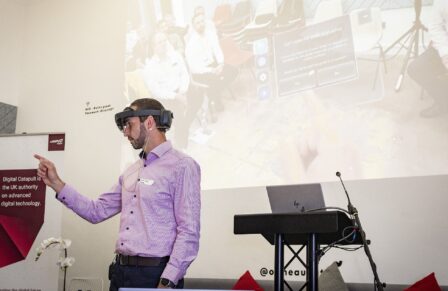Exploring the potential of Open RAN technology through the SONIC Labs programme
Posted 3 Oct 2022
Exploring the potential of Open RAN technology through the SONIC Labs programme
Dr Dritan Kaleshi, Director of Technology – 5G and Co-Director of SONIC Labs at Digital Catapult
5G is here and it’s already going beyond the way we connect with each other, providing countless new business use cases such as digital industrial manufacturing and smarter supply chains as demonstrated in our 5G trials and testbeds programme, and even advancing the creative industry to enable remote music production and virtual festivals. With the government aiming to have the majority of the UK population covered by a 5G signal by 2027, we’re on a journey to unlocking its full potential.
Diversifying the UK telecommunications supply chain is crucial, in addition to increased resilience to future trends and threats, it will help build an open and diverse telecommunication supply chain that can accelerate innovation and bring new opportunities for 5G and beyond.
The UK Government is addressing this through their 5G Diversification Strategy, and is working with organisations such as Digital Catapult and Ofcom to support the acceleration of diversification and establish UK expertise and capability within the telecoms supply chain. A key aim is to enable 5G (and beyond 5G) mobile networks to be built using a variety of different equipment suppliers through driving forward the rollout of a new wireless communication technology known as Open Radio Access Networks (Open RAN).
But how is Digital Catapult involved in enabling the development and adoption of the technology?
What is Open RAN?
Open Radio Access Networks (Open RAN) is a new approach to building mobile networks. Instead of vertical single-vendor integrated RAN solutions, with opacity and Original Equipment Manufacturer (OEM) vendor products used from larger vendors, Open RAN goes one step further in creating multi-vendor end-to-end networks by opening up the interfaces inside the Radio Access Network (RAN) and thus enabling mobile network operators to use RAN functions and equipment (such as the Radio Unit, Distributed Unit and Centralised Unit) from multiple vendors – subject to product interoperability.
In a recent blog, Ofcom compared Open RAN to Lego, explaining how it allows suppliers to build and improve their networks using different bits of technology, which can be used together in the same way that Lego bricks can be joined together.
”It allows operators to ‘mix and match’ different elements to build their networks, instead of only using components provided by a single supplier. Examples could include separate hardware and software elements (either of which could be manufactured by different suppliers, for example), which the network operator can source and integrate into their existing network.”
Ofcom
What are the potential benefits of Open RAN technology?
Adopting an Open RAN approach brings with it a number a benefits, including:
- Diversifying the supplier ecosystem: Open RAN technology helps to avoid vendor lock-in by ensuring that interfaces within a fully disaggregated RAN are based on open interface specifications and standards, thus enabling new vendors and products to be added as the network evolves.
- Introducing innovation pathways:
-
- Open RAN opens new opportunities for innovation and agility for mobile network operators by breaking the RAN up into component parts, each of which can be separately designed and configured.
- Most of the Open RAN products will allow flexible deployment and architectures suited for the specific environment, be that private mobile network in a factory, or public access network
- The network control is revamped with much finer detail, and no longer proprietary, with Open RAN standards accessible to third-party software developers who can develop new types of services and innovate on the RAN Intelligent Controller (RIC) by building xApps and rApps, addressing and solving problems and scenarios not previously considered.
- New revenue opportunities in private cellular networks and shared/wholesale neutral hosting: Operators can customise RAN hardware and software in an Open RAN deployment to deliver bespoke features based on the enterprise use cases and deployment scenarios. They can build their own service differentiators through the RIC and xApps and rApps, and align their commercial and retail strategy with the network performance and Service Level Agreements (SLAs) in a way that is not possible with generic features and functions of the RAN today.
Despite the potential opportunities, there are also many challenges ahead and uncertainties. One example in this space is the potential to lower the total cost of ownership (TCO) which is still open to debate. On one hand Open RAN allows the use of commodity hardware and existing digital infrastructure and optimal architectures, on the other hand multi-vendor integration, operation and management builds in additional work and complexity in network build and operation. This is exacerbated by the fact that introducing Open RAN solutions at scale might require at least a significant adaptation, if not a full break away, from the current one-to-one business model engagement between operators and equipment vendors.
Part of our SONIC Labs activity is focused to explore how we can understand, together with the industry community, the tradeoffs here and provide evidence-based arguments in the debate without technology partisanship. We believe that automation is key to managing the lifecycle of disaggregated, cloud-native RAN functions, to reduce the additional costs, and perhaps making it better with a fully cloud native approach. It will then be possible for Open RAN solutions to bring down the network TCO (such as resource distribution, operations) by evolving the network towards continuous integration and continuous delivery, rather than through generational investment cycles. Although, achieving this goes to the core of the business model and change is required, which will be enabled by the technology but will also influence how the technology is developed. Once this is in place, the fine grained network control and network optimisation has the potential to improve quality and lower costs such as energy use, coverage and performance optimisation.
Introducing our SONIC Labs programme
I’m thrilled to be co-director on the SONIC (SmartRAN Open Network Interoperability Centre) Labs programme at Digital Catapult, and to work with Ofcom in shaping and delivering one of the most exciting capability builds and delivery interventions in open networks in the UK. In this leading programme we’re partnering with Ofcom to help encourage new solution providers to enter the telecoms supply chain in the UK. The project aims to drive forward the rollout of Open RAN technology through providing opportunities for organisations to integrate their Open RAN products into working end to end systems, and enabling testing in indoor mobile network settings.
SONIC Labs provides a commercially neutral collaborative and technically supported environment for testing interoperability and integration of end-to-end OpenRAN network solutions. This environment is used to carry out a programme of engagement with the telecoms ecosystem with innovative vendors and products and potential adopters. Through this work SONIC Labs, together with the wider stakeholder groups around it from vendors, operators (large and small), regulator, integrators, industry researchers and academia, examines and shares the reality of Open RAN technology and subsequent open, disaggregated and software-centric network products and solutions.
The first phase of SONIC Labs (SONIC 1, 2020-2021) looked at building and testing end-to-end multi-vendor Open RAN systems, to explore the opportunity for creating an independent telecoms laboratory. It aimed to test if an integration and interoperability focused activity could address the lack of diversity in telecoms providers in the UK, including direct and full engagement with mobile industry in this process as key stakeholders in the diversification journey.
In our fully operational second phase we will test the integration of products in both a lab and field (indoor and outdoor) environments, looking at the maturity of the interfaces, easiness of integration, and sufficiency of interface specifications to support building interoperable end-to-end 5G OpenRAN systems with multiple vendors. We are encouraging innovative suppliers to participate in the UK telecoms ecosystem to provide a quicker path towards deployment in UK networks, as well as take the experience of integrating in the SONIC Labs environment to other regions internationally. It builds on what we learned with the first project with a focus to build a state of the art test and measurement facility to underpin our integration testing, but also investing on automation.
Over the past few months we have been busy working with the first five companies on the SONIC Labs testbed to integrate and trial their Open RAN products, in addition to the eight participants that we had the pleasure to work with in the first phase on SONIC Labs.The companies going through the SONIC Labs integration run include: Benetel, Cable Free, Effnet, IS-Wireless and Phluido. We’ll be onboarding further companies to our testbed in the coming months so keep an eye on our website for future calls and opportunities to get involved with SONIC Labs.
Future proofing the 5G supply chain
Overall, through our SONIC Labs programme we’re excited to be supporting the technology exploration, product development and the adoption of Open RAN technology. Our interoperability and integration focus is the technical lever to bring vendors together in mid-technology readiness level product development, and connect them with operators, thus leading to the potential to diversify the UK 5G supply chain so it is fit for the future – making it more secure and accessible for new market entrants.
We’ll be publishing further updates on Open RAN and our SONIC Labs programme in further blogs this week – watch this space!





